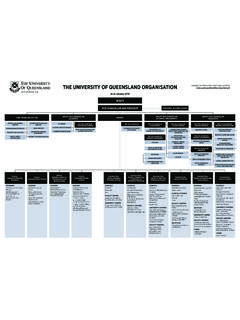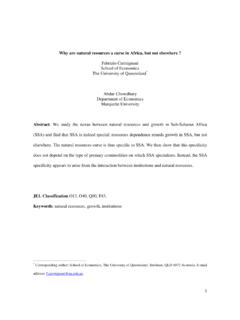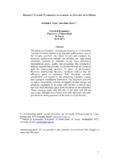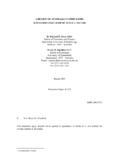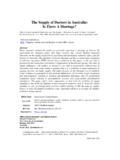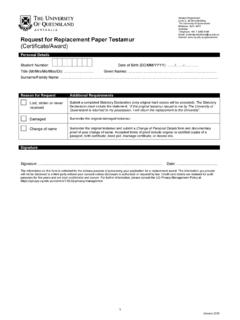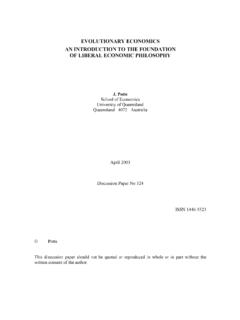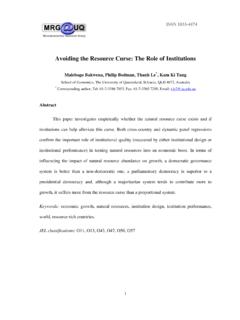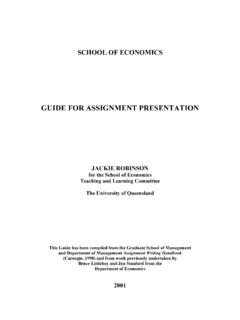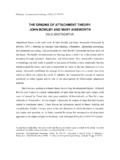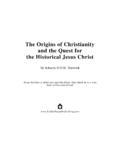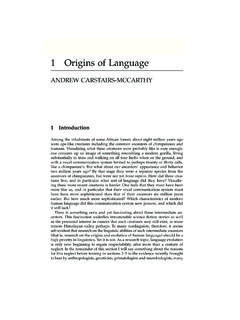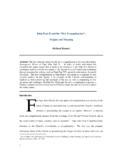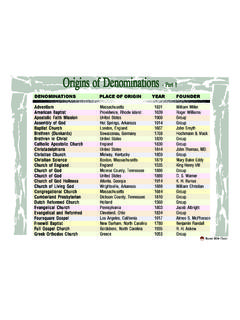Transcription of The Origins of the University of Queensland’s Coat …
1 UQ Heraldry Project The University of Queensland s Coat of Arms: Historical Aspects Produced by Histori|co Research Services, Centre for Applied History & Heritage Studies, School of History, Philosophy, Religion & Classics Introduction The University of Queensland s coat of arms is an instantly recognizable symbol of the University s corporate identity. Granted to the University in 1912, it has undergone a number of cosmetic revisions and changes, but the motto and essential design have remained constant. The Origins , significance and evolution of the coat of arms are not examined in detail in the published histories of The University of Queensland. This report was commissioned by the Fryer Library to address this oversight, and to thus document the heraldic history of the University using archival and unpublished sources.
2 The shorthand of history Heraldry is the practice of creating, managing and studying coats of arms, which are also referred to as armorial bearings or simply arms .1 Heraldry in some form has been practiced since at least the twelfth century, though its exact Origins remain obscure. The traditional argument is that the identity of individual knights was obscured by their full-body armour. Consequently, coats of arms were created and displayed in a prominent place (usually a shield or banner) to identify the knight. As the practice was taken up, rules and institutions governing the use of coats of arms evolved. Heralds, responsible for the organisation of tournaments, took on the role of experts in the identification of coats of arms. Important families and, by the fifteenth century, corporations, increasingly employed coats of arms, adding to the social value of armorial bearings.
3 Because of its genealogical significance, Arthur Charles Fox-Davies, a well-known writer on the subject, described heraldry as the shorthand of history . There are heraldic rules that determine the granting of arms and their composition. In 1912, it was generally perceived that the most appropriate fonts for a grant of arms for an Australian University were the English Kings of This path to a grant of arms continues to be open to Australians to this day, as seen in the example of St Johns 1 Armorial bearings can apply to other designs such as banners, seals and so on. Some historical sources (such as those used in this report) also refer to armorial bearings as armorial ensigns . Unless directly quoted from a contemporary source, armorial bearings , arms and coats of arms are used in this report.
4 2 The Kings of Arms are members of the Royal Household. There are three in total: Garter King of Arms, Clarenceux King of Arms and Norroy and Ulster King of Arms (formerly simply Norroy King of Arms). 1UQ Heraldry Project College, University of Queensland, and the procedure is the same as it was in 1912 To receive a grant of arms from the English Kings of Arms, one must first petition the Earl Marshal of England. If the petition (also known as a memorial ) is approved, the Earl Marshal then issues a warrant to the Kings of Arms, at which stage the design of the coat of arms begins. Though the petitioner has some input to the eventual design, the Kings of Arms are ultimately responsible for the finished product, thus ensuring each armorial bearing is unique. When completed, the coat of arms and its technical description (referred to as the blazon ) are recorded in Letters Patent.
5 The blazon is the most important element of the Letters Patent. It lists the various components of the arms and their organisation, in technical language, so that the arms can be distinguished from other armorial bearings. The Letters Patent are then registered with the College of Arms. 3 A coat of arms consists of several constituent parts. The distinguishing symbols ( charges ) of a family or corporation are displayed on the shield . The rule of tincture stipulates that a colour cannot overlay another colour, or metal over The crest comprises images that sit atop the shield, resembling the crest once worn on a knight s helmet. The supporters are the creatures, sometimes fantastic, that support the shield. The motto usually completes the arms and is typically displayed below the shield.
6 In English heraldry, while the motto may appear in the Letters Patent, it does not actually form part of the grant, and can be changed at will. The University of Queensland s coat of arms consists of a shield and motto. It does not have a crest or supporters. The blazon is: Or, a Cross Patee azure surmounted by an open Book proper . Or is the heraldic term for gold (metal) and azure means blue (colour), therefore satisfying the heraldic requirement that only metal and colour can be combined. (If the coat of arms is reproduced in black and white, the colour and metal can be represented by specific patterns, for example Or (gold) by dots and Azure (blue) by horizontal lines.) The two charges are the Cross Patee and the open Book proper . The Cross Patee is a particular kind of cross, often called the Maltese cross, since it was used as an identifying symbol by the Knights of Malta.
7 Crosses are common heraldic charges. The open Book proper 5, signifying knowledge and learning, is commonly associated with the coats of arms of universities. The motto, Scientia ac Labore, is generally translated as by means of knowledge and hard work . A Practical and Progressive University 6 The origin of the coat of arms of the University of Queensland is closely associated with the establishment of the University and contemporary debate over its purpose. 3 Another source of grants of arms is the Lyon King of Arms, based in Edinburgh. In the same year as the University s grant, Emmanuel College received a grant of arms from this source. Lord Lyon generally makes grants to individuals and institutions with Scottish connections. 4 There are only two metals in heraldry: gold and silver (often represented as yellow and white), and five colours: azure, gules, purpure, sable and vert.
8 Because metals tend to possess a lighter tincture and colours a darker one, metal cannot be placed on metal or colour on colour. This rule reflects the early use of armorial bearings as a form of identification, especially from a distance. 5 Proper in heraldic terms means in its proper colours . This can sometimes lead to a little variation in artistic interpretation. 6 Quoted in Malcolm I. Thomis, A Place of Light and Learning: The University of Queensland s First Seventy-five Years, St Lucia, University of Queensland Press, 1985, p. 13. 2UQ Heraldry Project Calls for a University in Queensland began as early as the 1870s. There was, however, some resistance to the idea. Queensland at this time was a largely rural and decentralized society, and practical skills, rather than intellectual pursuits, were considered paramount.
9 The limited government expenditure in this period was directed toward key areas such as land development, ports and railways, and elementary (rather than higher) education. Debate over the creation of a University , where it existed at all, generally centred on the subjects to be taught. Practical subjects of relevance to the economy, to some extent already covered by other educational facilities such as Technical Colleges, were favoured in business and political circles. Others advocated more traditional subjects in the Liberal Arts as taught at universities in Britain and Europe, the presence of which, it was argued, would confer a mark of civilization on Queensland The debate went through various phases, and numerous plans were proposed and discussed, long before concrete action was taken.
10 As University historian Malcolm Thomis points out, The pursuit of ideas would inevitably take second place to that struggle to conquer the environment and make the land yield up its treasures, which was the central theme of the state s growth in the nineteenth century .8 Despite the prolonged debate, advocates for a University continued to lobby the Colonial (and later, State) Government and the public at large. By 1906 a University Movement had been created and support for the establishment of a University was at its highest peak in over thirty A University Bill was introduced into the Queensland Parliament in November 1909 and was passed. A Senate was created and a site for the University the Government House Domain, located next to the Botanical Gardens was selected. Sir William MacGregor, recently appointed governor of Queensland, was nominated as the Chairman and Chancellor of the first Senate of the University .
